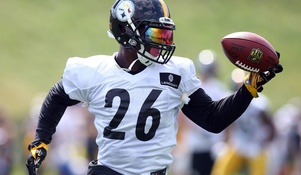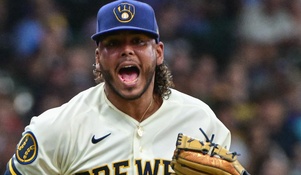Five reasons that the Pirates missed the playoffs in 2016
In 2016, the Pittsburgh Pirates missed the postseason for the first time in four seasons. After three straight seasons of at least 88 wins, the Pirates suddenly recorded their 21st losing season in the last 24 seasons.
As the sun continues to rise on the 2017 season and spring training nears its midway point, the focus is on how the Pirates can spend mid-October on the baseball diamond instead of the golf course. To do that, the Pirates must improve in five pivotal areas in 2017.
Batter Strikeout Percentage
2016 was undeniably Andrew McCutchen’s worst season in his eight-year career. Aside from posting career-worsts in WAR (-0.7), batting average (.256) and on-base percentage (.336), McCutchen also recorded a career-worst 21.2 strikeout percentage.
It wasn’t just McCutchen swinging and missing regularly: David Freese (28.9), Sean Rodriguez (29.8) and Gregory Polanco (20.3) also whiffed too often. All in all, the Pirates finished 12th worst in MLB in K%, which calculates how many strikeouts a hitter records per at bat, with a 21.3-percent mark. Of the 11 teams below the Pirates, only three made the playoffs.
Perhaps the Pirates’ struggles with strikeouts stemmed from wanting to hit home runs. McCutchen led Pittsburgh with 24 long balls and the Pirates finished 26th in home runs last season. With McCutchen struggling, perhaps the rest of the team was looking to help make up the offense lost.
Rodriguez is gone, but the best way for the Pirates strikeout percentage to decrease would be by shortening swings and getting a bounceback year from McCutchen. Power was not Pittsburgh’s specialty in 2016 and will not be in 2017 either. The Pirates need to just get on base and focus on advancing runners instead of trying to bring them all home on one swing of the bat.
Batter Ground Ball Percentage
In order to cut down on strikeouts, the Pirates have to put the ball in play. However, those balls need to turn into hits. Pittsburgh hit more ground balls than 21 other teams in 2016, finishing with a 44.3 GB%. A stat like that explains why the Pirates finished third-to-last in MLB with 3.80 runners left in scoring position per game.
Take Starling Marte, for example. Prior to 2016, his GB% dipped below 50-percent just once (2014). Last season, Marte’s 48.3 GB% was the second-lowest of his career and in turn, he hit a career-best .311.
That said, Marte only hit nine home runs in 2016, his fewest in the four seasons that he’s made over 200 plate appearances. This means that Marte’s changed approach at the plate meant focusing on contact instead of power. However, Marte still generated his second-best career fly ball percentage (28.4) and hit more balls into the opposite field than any other year (25.1-percent of balls hit).
In his rookie season of 2012, it seemed like Marte was swinging out of his cleats at every pitch after homering in his first MLB at-bat. It resulted in career-worsts in K% (27.5) and GB% (57.0). He’s far from that player now.
Freese (60.7 GB%, .270 AVG) and Cervelli (56.0 GB%, .264 AVG) finished first and second, respectively, on the Pirates in ground ball percentage and must get the ball in the air and out of the infield as lineup regulars in 2017. Freese did collect 16 infield hits last season, but is not the most fleet of foot to expect to extend his career with that stat.
Fielding Independent Pitching
Thus far, all of the above statistics’ have simple enough titles that have predictable definitions. FIP, according to FanGraphs.com, quantifies, “what a player’s ERA would look like over a given period of time if the pitcher were to have experienced league average results on balls in play and league average timing.”
In effect, FIP measures what a pitcher can control in a game (home runs, walks, strikeouts, etc). Similar to ERA, the higher the FIP, the worse the pitcher is. Last season, the Pirates finished 18th in MLB with a 4.30 FIP.
In a short showing, Ivan Nova led all Pirates pitchers in FIP for those that pitched at least 20 innings last season. Nova’s 2.62 FIP was aided by his stellar 7.24 K/9 and 0.56 HR/9 as well as his team-best 0.42 BB/9. Every other Pirates pitcher walked at least 1.47 batters per game.
It’s hard to predict if Nova’s FIP success will continue in 2017. Nova has never finished an entire season with a FIP below 3.47 (his cumulative 2016 FIP w/Pirates and Yankees was 4.11), but he also spent the majority of seven seasons at homer-friendly Yankee Stadium. Nova is a wild card in 2017; anything can happen.
As a whole, the Pirates starters are better than relievers in terms of FIP. Returning starters Nova, Gerrit Cole (3.33), Jameson Taillon (3.71) and Chad Kuhl (3.95) all finished with FIP’s below 4.00. The only returning Pirates relievers with FIP’s below 4.00 are Antonio Bastardo (3.94), Felipe Rivero (3.81), Juan Nicasio (3.78) and A.J. Schugel (3.19). That said, all of them, except for Schugel, averaged at least 3.43 BB/9.
The cluster of relievers with FIP’s over 4.00 include closer Tony Watson. In his first year as a closer, Watson converted 15 of 20 save opportunities with his worst ERA (3.06) and BB/9 (2.66) in four seasons. Watson’s 4.37 FIP was his worst since his rookie season (4.66) and his 1.33 HR/9 was a career-worst.
Whether Watson is closer material or not is a discussion not worth having if he repeats his 2016 stats; he won’t keep his job. Watson’s struggles are a primary reason that Pirates fans were angry with the Mark Melancon trade, despite how strong Felipe Rivero was once coming to Pittsburgh.
Four of the Pirates five worst FIP pitchers in 2016 are gone and all five were starters. Steven Brault and his 5.07 FIP remains, but he is fighting for the fifth-starter spot. If all but one of the Pirates 2017 starters has a strong FIP, the starting rotation will be far more effective.
Ultimate Zone Rating
UZR is an intriguing sabermetric that does an excellent job of rating how effective a fielder is. Sure fielding percentage is nice, but that only takes the quantity of putouts plus assists and divides it by the quantity of the sum of putouts, assists and errors. The more errors a player makes, the lower the fielding percentage.
UZR is a more effective way at looking at fielding percentage because it includes errors and much more on its calculations. It examines how many runs a player saves due to his defensive work. The higher the UZR, the better.
Recall Aug. 9, 2016. The San Diego Padres and Pirates battled on a late-summer Tuesday night. The Pirates won 6-4, but an interesting play occurred in the first inning.
With Yangervis Solarte at first and two outs in the inning, Pirates’ starter Chad Kuhl was looking to get out of the inning unscathed and without adding too many more pitches to his growing pitch count.
Kuhl had Padres outfielder Alex Dickerson down 0-2 in the count and delivered a fastball to the lower quarter of the plate. Dickerson lofted the ball to centerfield. McCutchen, shifted slightly into left field, dashed over to grab the ball, but did not play it deep enough. At only 5-foot-10, McCutchen’s flailing leap was not enough to make the play and Dickerson succeeded in driving Solarte in. 1-0, Padres.
However, McCutchen did not receive an error for the play and the run counted against Kuhl’s earned run average. That said, McCutchen’s inability to grab the ball was one of many reasons that he was moved to right field this season and why he finished with such an awful UZR in 2016. McCutchen’s -18.7 UZR was the worst among 18 centerfielders that played at least 800 innings in centerfield last season.
McCutchen wasn’t the only Pirate struggling in the field. Jordy Mercer, whose nine errors were the fifth-fewest qualified shortstops, had the fifth-worst UZR (-8.4) at his position. Kang regressed at third base in 2016 (-2.9) after a solid 2015 (1.5). John Jaso (-1.3) and Josh Bell (-2.2) proved underwhelming in their first major league seasons at first base.
As an entire unit, the Pirates finished 26th in MLB with a -33.0 UZR. In the curse-breaking 2013 season, Pittsburgh finished 15th with a 4.4 UZR and came within a game of advancing to the National League Championship Series. Since then, the Pirates have not posted a positive UZR in a single season and have not made it past the Wild Card Game. UZR isn’t the only reason that the Pirates have under-achieved in recent seasons, but it’s a pivotal one.
Moving Marte (7.5 UZR in left field) to center and Polanco (5.9 UZR in right field) to left should help improve the Pirates outfield defense, considering two centerfielders are essentially needed to man center and left at PNC Park. As for the infield, the Pirates have to hope that Jaso and Bell improve in their second years at first and that Mercer can return to his 2015 form, when he recorded a career-best 1.5 UZR.
With an unproven rotation filled with question marks, the Pirates need their defense to help bail out younger pitchers like Tyler Glasnow, Brault and Kuhl, who cannot be expected to go deep into games.
Base Running
Despite Marte stealing a career-high 47 bases in 2016, the Pirates were not much of a threat on the basepaths and often made too many mistakes on them. Pittsburgh finished 2016 eighth-worst in MLB in BsR, which calculates all decisions that runners take on the basepaths and their results, with a -7.0 mark.
110 stolen bases aside, the Pirates got picked off 17 times (tied for second-most) and made 62 outs on the basepaths (sixth-most), per MLB.com
Marte led the Pirates and finished seventh in MLB with a 7.0 BsR in 2016. Besides Marte, only Jordy Mercer, Josh Harrison and Adam Frazier finished with BsR’s over 1.0. Other lineup regulars like John Jaso (-5.5), Jung-ho Kang (-3.1) and Freese (-4.2) finished with unimpressive marks.
McCutchen, who has stolen 20 or more bases five times in his career, posted a -3.0 BsR and only stole six bases in 2017.
In an attempt to fix baserunning mistakes, the Pirates fired baserunning and third base coach Rick Sofield and reassigned first base coach Nick Leyva to senior adviser of baseball operations.This year, Kimera Bartee and Joey Cora will take over at first base and third base, respectively.
Bartee has never coached in the majors before, but Cora has experience with base-runners. Under Ozzie Guillen, Cora served as the Chicago White Sox third-base coach from 2004-06. In that three-year span, the White Sox finished in the middle of the league all three years in BsR, but with negative averages each season.
Despite Cora’s average history as a third base coach and Bartee’s lack of MLB coaching experience, the Pirates are hoping that a change in coaching will provide a spark to a lackluster baserunning unit. The Pirates don’t need to just steal bases, they need to make smarter decisions on the base paths.
The Pirates suffered a 20-win differential from 2015 to 2016 because of all five reason above. Simply put, these struggles can’t happen again in 2017 if the Pirates hope to get the second wild card at the absolute least. After a quiet offseason that saw the biggest transaction be the non-trade of McCutchen, the Pirates are stuck with last season’s culprits. Unless Pittsburgh gets drastic improvements in these five areas, another season on the outside of playoff baseball is most likely.




